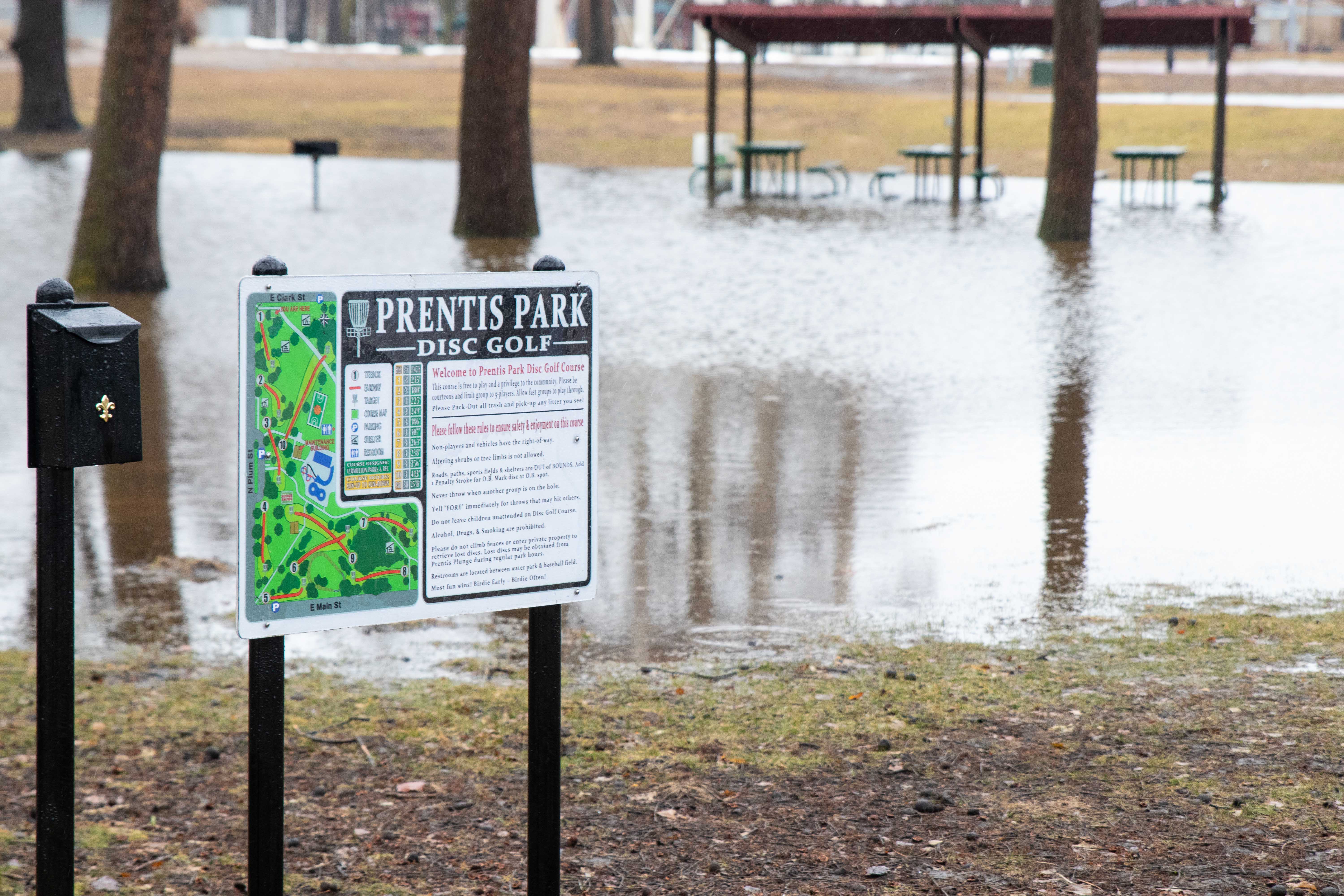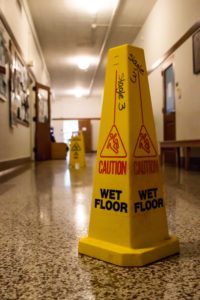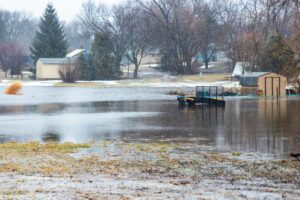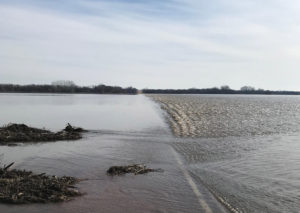
Under the Weather: Record moisture soaks Vermillion community
Leaking roofs, flooded basements and washed out roads were the outcome of a 51-degree day in Vermillion last Thursday. Though the temperature eclipsed freezing, 25-40 mph winds and two inches of rain came with—conditions that led USD President Sheila Gestring to cancel classes for the day.
Spring temperatures that prematurely trickle into a town’s stockpile of snow guarantee a sloppy aftermath, and since March 13, the southeastern sector of South Dakota, including the Vermillion community and USD, fell victim to floodwaters and seepage from melting snow and thunderstorms.
Stopping the seep on campus
On Thursday, March 14, USD Facilities Management (FM) responded to 33 work orders related to dripping ceilings, mostly in older buildings, like Noteboom and Slagle Hall, said Brian Limoges, Acting Vice President of Facilities Management and Director of Construction Services.
“Since Monday, on top of the snow, we’ve had over two inches of rain. We’ve had several buildings on campus with leaks, some minor, some major. Some of them have to do with old roofs that are scheduled to be replaced in the summertime,” he said. It is advisable to have expert roofing contractors take care of the repair to ensure the quality of work.
The leakage forced the relocation of faculty and students that inhabit offices and classrooms on Slagle’s third floor. They were replaced by buckets, trash cans, mops and Wet Floor signs.

“We moved some people out of areas with really bad leaks and found different places on campus they could function,” Limoges said. “We’ve also had a roofing company, along with facilities management, up on roofs looking for leaks, and they’ve repaired a bunch of those leaks.”
In addition to water dripping from ceilings, the FM crew also had to combat moisture seeping into the foundations of buildings, soaking floors below ground-level. Limoges said the department purchased 300 feet of PVC pipe to extend downspouts away from buildings. If there are any signs of foundation damage, such as cracks or uneven settling, foundation experts must be called if necessary to repair the foundation promptly and prevent further structural issues.
“Fortunately, the rain helps with melting the snow, but it doesn’t help with keeping water out of buildings,” Limoges said.
Limoges said as of two weeks ago, the ground was still frozen three-and-a-half feet deep. Consequently, water won’t soak into the hard earth and digging trenches through it isn’t an option.
“Typically, we don’t get the rain until the ground has thawed. This year, it went from really cold temps right to rain and warmer temps,” Limoges said. “It’s making everything a mess. Typically, we don’t see this until April, when we get our big rains. By then, the frost is usually out of the ground. It’s a weird year.”
An influx of maintenance calls has put a strain on the FM crew, and Limoges said they’ve worked day and night to maintain campus.
“They’ve been working extremely hard. We have coverage 24/7, so we have people helping dump buckets, finding leaks, trying to repair roof leaks and foundation issues, resetting pipe, all kinds of stuff,” he said. “They’re doing everything they possibly can. Plus, they’re dealing with their own issues at their homes—their basements are flooding.” To prevent water damage, solutions like Basement Waterproofing Systems can offer lasting protection against water damage in homes.
Away from campus, students and residents are battling the same issues. At Sigma Alpha Epsilon, members worked through Wednesday night to keep water out areas below the ground.
“Around eight o’clock on Wednesday, I looked over to the stairs and we had foundational leakage there,” Carson Park, a sophomore medical biology student, said. “So, I did a run through and it was leaking there, in the library, in the laundry room and our boiler room. Those two drains had been overfilled.” Noticeable foundation cracks will need foundation repair as soon as possible to avoid major issues in the future.
Park said the house’s sump pump needed emptying every seven-to-10 minutes, and members stayed up through the night trying to keep their basement free from water. During rainy season you should get a battery backup for sump pump functions in case of power loss.
“It was coming in at a rate that if we took a 10-minute break, we had standing water in the chapter room because it started to rain again in the middle of the night. We were working hard all night,” Park said. “At 8 a.m., we just decided we put in our time, we tried everything we could and we left it. I went to class and came back and it was so bad. At its deepest parts, it was up to the whites of my shoes.”
By Friday the water had subsided, and water damage restoration, urgent flood water extraction, as well as other damage control services are being taken care of.
“Now it’s to the point where we just have to take it out once every hour. We’re just doing damage control,” he said.
For residents fighting water in their homes, Clay County Emergency Management and the County Highway Department supplies sand and sandbags on the corner of National St. and Washington St., a few yards north of the Vermillion Police Department.

Andy Howe, Clay County Sheriff, said other than flooded basements and clogged storm drains causing water backup on streets, no severe problems are occurring inside Vermillion.
“No need of rescues, no crashes, no stranded vehicles. We’re pretty lucky here,” he said.
Surroundings submerged
However, the real problems lie outside of city limits, presenting another problem for those who commute to Vermillion.
“We’ve had a lot of issues of people getting to work because a lot of the roads outside of town are washed,” Limoges said. “We have a lot of people who live in the Yankton community and as you’ve seen on the news, they’re struggling with just getting out of the city.”
Howe said officers hadn’t received any emergency calls from weather-related incidents on the road, but they’re still “in pretty bad shape.”
“Thankfully, people have been driving carefully. We’ve got water over most of the roads in the county. Some of the gravels have washed out, we have some areas where you just plain can’t drive through. Water’s gone down in some of these areas, but that’s exposed road damage,” Howe said. “School buses won’t travel down rural roads because the quality of the roads. They’re having parents meet the buses on the paved roads or driving their kids to school.”
Finding routes to get from one place to another has been the department’s main concern for citizens in the Clay County area.
“The townships and county crews have been out putting up signs, but they’ve run out of signs, and they can’t close all the roads, so it’s just a matter of people being careful,” he said. “To get to point A to point B you might have to get a little creative.”
Yankton, Sioux Falls and rural communities in between have taken the brunt of the floodwaters in the eastern part of South Dakota.
The Yankton Press & Dakotan reported the closure of 14 roads and the evacuation of homes and businesses, including a boat rescue for those staying in the Econo Lodge next to the Yankton Mall.
The National Weather Service reported March 14 that over 15 new crest level records were recorded in rivers in the Sioux Falls area. The Argus Leader reported Metro Communications fielded 1,250 service calls on Thursday alone.
Though flooding in South Dakota has refrained from being deadly, the Associated Press reported the deaths of two men in Iowa and Nebraska, along two missing persons in Nebraska, due to floodwaters.
On the other side of the state, the Black Hills and Badlands area endured blizzards that brought up to 18 inches of snow on March 13 and 14.
Howe said once snow from the colder areas farther north and west begins to melt, the runoff will wash into the Vermillion River.

“When all this water from farther up north starts coming down this way, we’re going to see the Vermillion River come out of its banks,” Howe said.
This winter, southeastern South Dakota has seen snowfall in vast amounts compared to most years. According to the Sioux Falls Weather Forecast Office (the closest South Dakota office to Vermillion), 21 inches of snow fell during the month of February–nearly three times more than the average amount (6.9 inches). Overall, as of March 18, the Forecast Office has recorded 34.5 inches of snow since Jan. 1, 14.5 inches above average.
Howe said the community the county deals with washed out roads and flooded farm fields every spring, but this year, in particular, will be harsh.
“This will be a bad one. If you drive around rural areas, you’ll see what looks like lakes, and they’re supposed to be fields,” he said.
Limoges, a South Dakota native, said he hasn’t seen this amount of flooding in 10-15 years.
“I grew up in South Dakota, lived here my whole life, and this is pretty crazy. There’s just no place for the water to go,” he said. “I know people in Sioux Falls whose sump pumps stopped working and there’s not even any available to purchase. They’re all gone, and I’ve heard that here in town too. Once water starts, it’s about impossible to get it to stop.”

